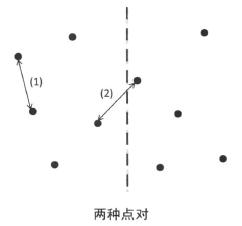Luogu 1429 平面最近点对 | 平面分治
Luogu 1429 平面最近点对
题目描述
给定平面上n个点,找出其中的一对点的距离,使得在这n个点的所有点对中,该距离为所有点对中最小的
输入输出格式
输入格式:
第一行:n;2≤n≤200000
接下来n行:每行两个实数:x y,表示一个点的行坐标和列坐标,中间用一个空格隔开。
输出格式:
仅一行,一个实数,表示最短距离,精确到小数点后面4位。
这是一道平面上的分治。
这是一个平面,我们把它分成两半,使x坐标位于最中间的两个点分到左右两侧:

对于同在左侧或同在右侧的点对,我们可以递归处理;对于分别位于两侧的点对,如何处理呢?
设递归处理后我们知道同在左侧和同在右侧的点对中,最小距离是d;那么需要枚举的“分别位于两侧的点对”的两个端点的横坐标一定都位于中线左/右距离不超过d的范围内。
当枚举左侧的一个点的时候,右侧只需要找y坐标更小,且y坐标相差不超过d的点,与左侧的点配对。
有了以上两条限制,对于一个点p,另一侧需要与它配对的点不超过6个。

至于具体实现,要先把所有点按照x坐标排序,然后再递归的过程中按照y坐标排序。子区间内部点的顺序被修改(从按x排序变成按y排序),并不会影响母区间的划分,因为在递归进入子区间前母区间已经划分好了。
AC代码:
#include <cstdio>
#include <cstring>
#include <algorithm>
#include <cmath>
#define space putchar(' ')
#define enter putchar('\n')
#define INF 0x3f3f3f3f
using namespace std;
typedef long long ll;
template <class T>
void read(T &x){
char c;
bool op = 0;
while(c = getchar(), c < '0' || c > '9')
if(c == '-') op = 1;
x = c - '0';
while(c = getchar(), c >= '0' && c <= '9')
x = x * 10 + c - '0';
if(op) x = -x;
}
template <class T>
void write(T x){
if(x < 0) putchar('-'), x = -x;
if(x >= 10) write(x / 10);
putchar('0' + x % 10);
}
const int N = 200005;
int n;
struct point {
double x, y;
point operator - (const point &b){
return (point){x - b.x, y - b.y};
}
double norm(){
return sqrt(x * x + y * y);
}
bool operator < (const point &b) const{
return x < b.x;
}
} p[N], a[N], b[N], c[N];
double solve(int l, int r){
if(l >= r) return 1e20;
int mid = (l + r) >> 1;
double xmid = (p[mid].x + p[mid + 1].x) / 2;
double d = min(solve(l, mid), solve(mid + 1, r));
int pos = l, pb = 0, pc = 0, pl = l, pr = mid + 1;
while(pos <= r){
if(pl <= mid && (pr > r || p[pl].y < p[pr].y)){
if(p[pl].x > xmid - d) b[++pb] = p[pl];
a[pos++] = p[pl++];
}
else{
if(p[pr].x < xmid + d) c[++pc] = p[pr];
a[pos++] = p[pr++];
}
}
for(int i = l; i <= r; i++) a[i] = p[i];
for(int i = 1, j = 1; i <= pb || j <= pc;){
if(i <= pb && (j > pc || b[i].y < c[j].y)){
for(int k = j - 1; k && b[i].y - c[k].y < d; k--)
d = min(d, (b[i] - c[k]).norm());
i++;
}
else{
for(int k = i - 1; k && c[j].y - b[k].y < d; k--)
d = min(d, (c[j] - b[k]).norm());
j++;
}
}
return d;
}
int main(){
read(n);
for(int i = 1; i <= n; i++)
scanf("%lf%lf", &p[i].x, &p[i].y);
sort(p + 1, p + n + 1);
printf("%.4lf\n", solve(1, n));
return 0;
}
本文作者:胡小兔
博客地址:http://rabbithu.cnblogs.com
博客地址:http://rabbithu.cnblogs.com


 浙公网安备 33010602011771号
浙公网安备 33010602011771号